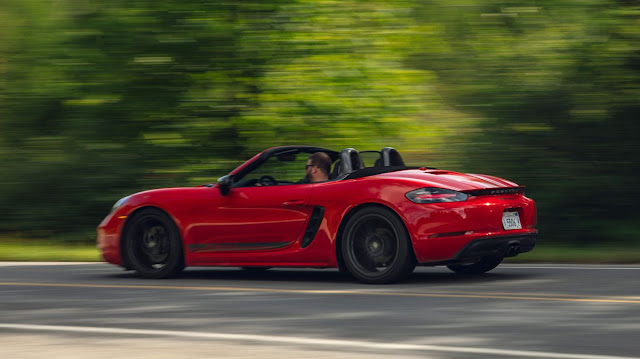2024 Porsche Cayenne S E-Hybrid Avoids a Certain Stigma
Adding an 'S' badge confers more prestige on the Cayenne E-Hybrid.
It's hard to imagine that any new Porsche could be a cause of badge shame, but for some buyers, evidently, there's a stigma around being seen in an entry-level version. For customers shopping the plug-in-hybrid Cayenne, the new 2024 Porsche Cayenne S E-Hybrid gives eco- and image-conscious customers alike an option that tells the world they don't settle for the mere E-Hybrid model.
The S E-Hybrid turns up the wick by way of extra power and a lengthier list of standard features, and it requires a minimum spend of $100,750, a $7400 upcharge over the Cayenne E-Hybrid. That's for the long-roof SUV body style. The fastback, or Coupe in Porsche parlance, stickers for $106,050. But is it worth it?
No Special Engine for This S
As with the strictly gas-fed Cayenne S, the Cayenne S E-Hybrid packs a heartier punch than its lesser kin. The S E-Hybrid is not, however, a V-8 Cayenne S with an electric drive motor and battery in tow. Snagging that combination requires making the jump to the $148,550 Turbo E-Hybrid.
Rather, the S E-Hybrid trades the standard E-Hybrid's 300-hp turbocharged 3.0-liter V-6 for a 348-hp version. Like all gas-electric 2024 Cayennes, the S E-Hybrid complements its internal-combustion engine with a 174-hp electric motor. Thanks to the fatter powerband of its V-6, the S E-Hybrid's combined output of 512 horsepower betters the Cayenne E-Hybrid’s by 49 ponies.
Porsche says the additional power helps the S E-Hybrid run to 60 mph in 4.4 seconds—0.2 ticks ahead of the standard E-Hybrid and equal to that of a gas-only Cayenne S with the Sport Chrono package—though we wager it will beat that claim by a few tenths of second once we get it to the test track.
Battery-Mode Bore
The slim acceleration advantage the S E-Hybrid has over the E-Hybrid is mostly nonexistent in the default E-Power drive mode, which effectively turns Porsche's spicy capsicum into a flavorless bell pepper. In this mode, the Cayenne avoids firing up its gas engine and instead prioritizes battery-electric driving, feeding the motor electricity from its rear-mounted 21.8-kWh (net capacity) battery pack, which we estimate will provide more than 30 miles of electric-only range.
The electric motor proved powerful enough to push the S E-Hybrid away from stoplights and putter along in stop-and-go traffic in the busy urban environs of Barcelona, Spain. Porsche claims the motor is capable of powering the vehicle up to 84 mph, but its limited output made it difficult to take advantage of open holes in traffic or complete passes at higher speeds without assistance from the gas engine. When the V-6 does make its appearance, however, the S E-Hybrid often overcompensates for the gas engine's delayed arrival with a sudden surge of excess power.
Solving this issue required twisting the steering-wheel-mounted drive mode dial—part of the standard Sport Chrono package—to Hybrid, Sport, or Sport Plus, all of which bring a more linear power delivery. (There's also an Offroad mode for those looking to take their Cayenne off the beaten path.) The S E-Hybrid is arguably at its best in its efficiency-oriented Hybrid mode, which still favors the electric motor but quickly calls upon the gas engine when necessary. Switching to Sport or Sport Plus keeps the V-6 on boil, ensuring the powertrain's full motivation is always at the ready.
Standard Air Suspension
Sp0rt and Sport Plus also firm up the two-chamber air springs, which use individual valves to independently control compression and rebound. They're a standard feature on the S E-Hybrid (and a $2390 option on the E-Hybrid). Left in its Normal setting, the air suspension contributed to the Cayenne's quiet and isolated cabin by deftly absorbing the speed bumps and other irregularities that occasionally dot Barcelona's freshly paved roads. But it's possible that U.S. roadways will reveal a less smooth ride over potholes and broken pavement.
On the twisting tarmac that snakes around Parc Natural de la Muntanya de Montserrat (Montserrat Mountain Natural Park), the suspension even in its softest setting made the hefty S E-Hybrid feel reasonably wieldy. Body motions remain predictable and controlled, even if there is still noticeable pitch and some roll in turns. The Cayenne we drove was optioned with summer rubber (all-season tires come standard) and well-bolstered 18-way power front seats ($1710), which together ensured that both car and driver remained firmly planted through the route's many high-g corners.
The Cost to Go S
Here's the rub, though. As impressive as the Cayenne S E-Hybrid is, its overall mass—well in excess of 5000 pounds—means it can't cosplay as a 911, even if it's shockingly capable for a vehicle this big and heavy.
There's no hiding the fact that wrangling this Porsche around tight two-lanes feels more like work than play. Nor are its additional standard features enough to justify the delta between it and the only marginally slower Cayenne E-Hybrid. Even when optioned with the S's upgraded wheels, headlights, and suspension, the regular E-Hybrid still undercuts the S E-Hybrid by $2710.








